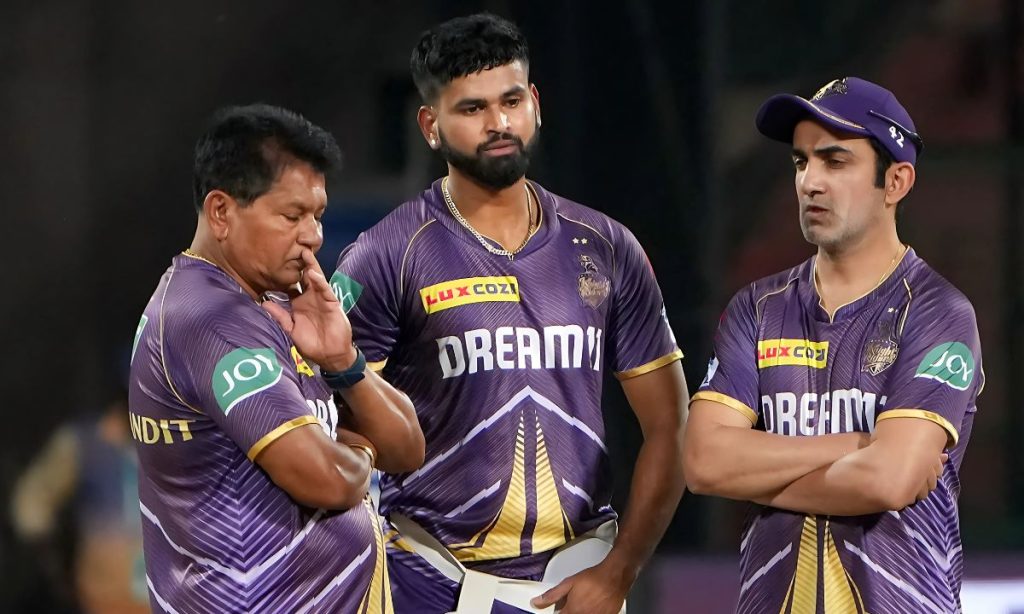The corridors of Indian cricket have rarely witnessed a selection debate as nuanced and heated as the recent confrontation between Gautam Gambhir and Ajit Agarkar.
The dispute, which has sent ripples through the cricketing fraternity, centered around the selection of Shreyas Iyer and the choice of wicketkeeper for the Champions Trophy 2025, exposing the complex dynamics within India’s cricket management.
This high-stakes disagreement has brought to light fundamental differences in vision and strategy between two of Indian cricket’s most influential figures.
The Core of the Controversy
Shreyas Iyer: A Performance Under Scrutiny
Despite initial discussions about potentially dropping Iyer, he emerged as a standout performer in the recent England ODI series, silencing critics and vindicating his supporters.
The middle-order batsman scored 181 runs at an impressive average of 60.33, including two match-defining half-centuries.
His ability to handle pressure situations and construct innings has added a new dimension to India’s batting lineup, making his selection debate particularly significant for the team’s future.
Middle-Order Dynamics
India’s middle-order strategy underwent a significant transformation, showing remarkable improvement across all metrics:
- Players in positions 4-7 scored 375 runs in three innings, demonstrating exceptional consistency
- Achieved a strike rate of 116.42, indicating aggressive intent while maintaining stability
- Produced three well-crafted half-centuries, showcasing depth in batting
- Outperformed England’s middle order, which managed only 278 runs at 23.16, highlighting the effectiveness of India’s strategy
The Wicketkeeper Dilemma
A key point of contention was the wicketkeeper selection, which evolved into a complex decision-making process. Ajit Agarkar had previously stated that Rishabh Pant was the preferred wicketkeeper for both the ICC tournament and England ODIs, citing his explosive batting ability and improved keeping skills. However, the team management, led by Gambhir and supported by captain Rohit Sharma, chose to back KL Rahul, considering his technical proficiency and recent form behind the stumps.
Gautam Gambhir’s Stance
Gambhir confirmed KL Rahul as the first-choice wicketkeeper, indicating a strategic shift in the team’s approach. He stated, “At the moment obviously, KL is our number one wicketkeeper, and he’s delivered for us.” This decision reflects a broader philosophy of prioritizing batting stability alongside keeping skills, marking a significant departure from traditional selection criteria. Rahul’s dual role as a reliable middle-order batsman and competent keeper has added valuable flexibility to the team composition.
Strategic Considerations
Left-Right Combination Strategy
Gambhir revealed a preference for a left-right combination in the batting lineup, which has introduced unprecedented flexibility in batting slots. This approach marks a departure from India’s previously top-order-heavy strategy and has several tactical advantages:
- Creates challenges for opposition bowlers in maintaining consistent lines
- Disrupts field placement strategies
- Enables better rotation of strike
- Provides options to counter specific bowling matchups
Performance Metrics
The performance metrics have become a crucial factor in the selection debate, with both Gambhir and Agarkar presenting data-driven arguments to support their positions. The statistics have shown:
- Improved middle-order stability
- Enhanced batting depth
- Better strike rotation
- Increased scoring rate in middle overs
- Superior wicketkeeping efficiency
These metrics have played a vital role in shaping the selection decisions and strategy formulation for the upcoming Champions Trophy 2025.
Comparative Analysis
- Shreyas Iyer’s Performance:
- 181 runs in the series, demonstrating remarkable consistency and adaptability
- Average of 60.33, showcasing his ability to anchor innings effectively
- Two half-centuries, both coming at crucial junctures and under pressure situations
- Exceptional strike rotation against both pace and spin
- Notable improvement in handling short-pitched deliveries
- KL Rahul’s Contribution:
- Played in all three matches against England, displaying unwavering commitment
- Maintained team continuity through consistent performances behind the stumps
- Preferred over Rishabh Pant due to superior batting technique and recent form
- Demonstrated excellent game awareness and leadership qualities
- Successfully managed partnerships with both top and lower-order batsmen
The Broader Implications
The selection controversy highlights several critical aspects of modern Indian cricket:
- The evolving role of team management in shaping long-term strategy and vision
- The importance of performance over predetermined selections, emphasizing meritocracy
- The delicate balance between strategic planning and individual player potential
- The need for versatility and adaptability in international cricket
- The significance of data-driven decision-making in team selection
A Turning Point
The Champions Trophy 2025 squad, which includes players like Rohit Sharma, Shubman Gill, KL Rahul, Virat Kohli, Rishabh Pant, Shreyas Iyer, and others, represents a critical juncture in Indian cricket.
The Gambhir-Agarkar clash symbolizes the passionate debates that shape team composition and strategy.
This watershed moment could potentially define India’s approach to limited-overs cricket for years to come, setting new benchmarks for selection criteria and team dynamics.
Final Thoughts
While controversies are not uncommon in cricket selection, this particular debate underscores the complexity of building a world-class cricket team.
It’s a delicate balance of individual brilliance, strategic vision, and collective team goals.
The resolution of this selection dilemma will likely influence future decision-making processes in Indian cricket, emphasizing the need for transparent communication and objective criteria in team selection.
The ongoing discourse between former players, selectors, and team management demonstrates the evolving nature of cricket administration and the increasing importance of strategic depth in modern cricket.

